Forschende sehen Weltnaturerbe Wattenmeer durch den Klimawandel ernsthaft bedroht
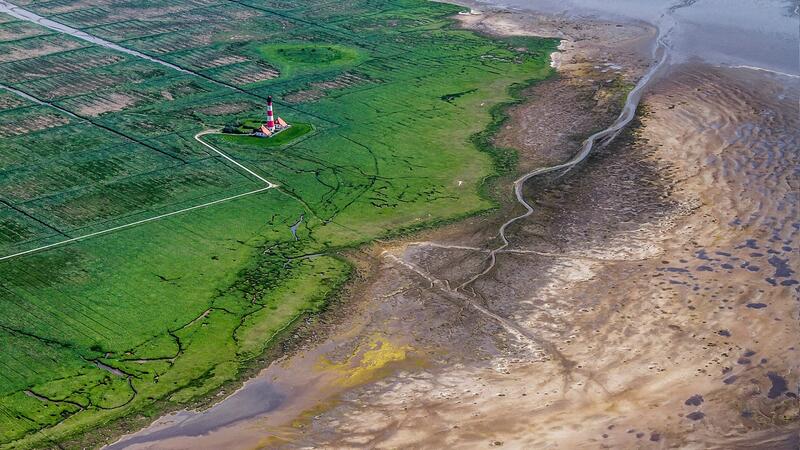
Vom 30.11. bis 2.12. präsentierten und diskutierten über 200 Expert*innen aus Dänemark, Deutschland und den Niederlanden die neuesten wissenschaftlichen Erkenntnisse über das UNESCO-Weltnaturerbe Wattenmeer auf dem 15. International Scientific Wadden Sea Symposium (ISWSS). Die Tagung war ursprünglich als Präsenzveranstaltung in Büsum geplant und fand nun als Onlinekonferenz statt.
Eine der größten Bedrohungen für das global einzigartige Ökosystem Wattenmeer ist der Klimawandel und der dadurch bedingte Meeresspiegelanstieg. Die Auswirkungen auf die Biodiversität und geologische Dynamik des Wattenmeeres sowie mögliche Schutzmaßnahmen standen im Fokus des Symposiums.
Vor diesem Hintergrund wurden sechs Themenfelder in eigenen Sitzungen konkreter beleuchtet: Vögel, Meeressäuger, Neobiota, sublitorale Habitate sowie sozioökonomische bzw. ökologische nachhaltige Entwicklung. Neben einer Vielzahl von Vorträgen zu den neusten Forschungsergebnissen wurden von den Expert*innen-Gruppen zu jedem Thema Empfehlungen für das Management des Wattenmeeres und der weitere Forschungsbedarf diskutiert und formuliert.
Das Symposium blickte auch über das Schutzgebiet vor der eigenen Haustür hinaus und ließ internationale Welterbe-Expert*innen sowie Gastvortragende aus dem koreanischen Wattenmeer, das seit diesem Sommer ebenfalls als Weltnaturerbe ausgezeichnet ist, zu Wort kommen.
„Die internationale Zusammenarbeit ist von großer Bedeutung für den Schutz der marinen Weltnaturerbestätten, da sie durch den Klimawandel besonders gefährdet sind. Die Trilaterale Wattenmeerzusammenarbeit leistet einen wichtigen Beitrag zum Schutz dieser sensiblen Ökosysteme und ist weltweit anerkannt“, so Ilka Wagner, Referatsleiterin Meeresnaturschutz im Bundesumweltministerium.
„Anhaltend hohe Zahlen neuer, bisher nicht heimischer Arten im Wattenmeer und ihre dauerhafte Etablierung zeigen, wie menschliche Faktoren zusammenwirken können", sagte Dr. Christian Buschbaum, Meeresökologe am Alfred-Wegener-Institut auf Sylt, der die Sitzung zu Neobiota moderierte. "Mit dem globalen Schiffstransport und durch Aquakulturen werden fremde Organismen eingeschleppt, die durch die Klimaerwärmung geeignete Lebensbedingungen vorfinden. Welche Effekte diese Exoten im Ökosystem zeigen, ist zentrales Thema der Forschung. Es ist eine zunehmend wichtigere internationale Aufgabe Maßnahmen zu entwickeln, um das Wattenmeer vor der Einschleppung weiterer fremder Arten zu schützen."
Zum Abschluss der dreitägigen Tagung fasste die Vorsitzende des Wadden Sea Boards, dem höchsten Steuerungsgremium der dänisch-niederländisch-deutschen Wattenmeerkooperation, die Erkenntnisse zusammen: „Die Wissenschaft zeigt, dass schon jetzt das Weltnaturerbe Wattenmeer durch den Klimawandel deutlich beeinflusst wird. Besonders herausgestellt hat das Symposium, dass der Austausch von Daten und Informationen zwischen den drei Ländern weiter intensiviert werden muss, um das Management zum Schutz des Wattenmeers auch an neue Herausforderungen anpassen zu können“, sagte Prof. Dr. Karin Lochte.
Die Ergebnisse sollen in die Ministererklärung der nächsten Trilateralen Regierungskonferenz der drei Wattenmeer-Anrainerstaaten einfließen, die auf Einladung Deutschlands zum Abschluss seiner Präsidentschaft der Trilateralen Wattenmeer-Zusammenarbeit Ende 2022 in Wilhelmshaven stattfinden wird und die politische Weichenstellung für den Wattenmeerschutz der kommenden Jahre bildet. Die Ergebnisse werden zudem unter dem Titel „Biodiversity and Ecology of the Wadden Sea under changing environments“ im englischsprachigen Journal „Marine Biodiversity“ veröffentlicht.
„Mit mehr als 200 internationalen Teilnehmenden wurde das virtuelle Symposium sehr gut angenommen. Dank der multifunktionalen Plattform klappte der kollegiale Austausch auch online super,“ freute sich Marina Sanns von der Nationalparkverwaltung Schleswig-Holsteinisches Wattenmeer, die das Symposium maßgeblich mitorganisiert hat. „Das war ein toller Abschluss unseres Nationalpark-Themenjahrs 2021 „Wissenschaft im Wattenmeer – Dem Verborgenen auf der Spur“.
Das 15. ISWSS wurde von der Nationalparkverwaltung Schleswig-Holsteinisches Wattenmeer in Zusammenarbeit mit dem Bundesumweltministerium und dem Gemeinsamen Wattenmeersekretariat (CWSS) organisiert. Im Rahmen der trilateralen Kooperation zum Schutz des Wattenmeeres findet diese Veranstaltung regelmäßig ein Jahr vor Ende der Präsidentschaftszeit eines der drei Wattenmeerstaaten statt. Das letzte Wissenschaftssymposium wurde 2017 im dänischen Tondern abgehalten.
>> Symposium Report
A visual take on ISWSS15
Science illustrator and researcher Jagoba Malumbres-Olarte listen in to the thematic sessions of the symposium. Below he explains his illustrations.
Overall illustration
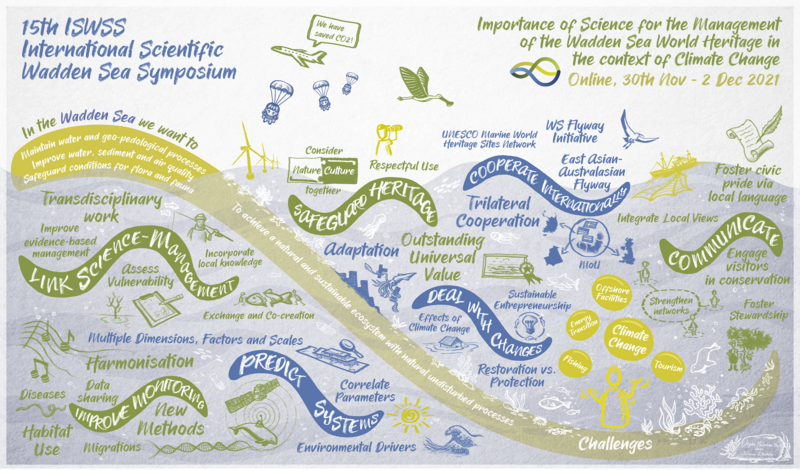 The overall illustration of the symposium highlights some of the main discussions as well as the general character of the event, starting with the fact that it had to be moved online at last minute - saving CO2 from the cancelled travel plans. With the Trilateral Wadden Sea Cooperation's Guiding Principle running through the image, its main challenges are shown in balls, needing to be juggled at the same time. Calls for action include safeguarding the Wadden Sea World Heritage, coorperating internationally, dealing with changes, linking science and management, improving monitoring, trying to predict the system and communicating the Wadden Sea.
The overall illustration of the symposium highlights some of the main discussions as well as the general character of the event, starting with the fact that it had to be moved online at last minute - saving CO2 from the cancelled travel plans. With the Trilateral Wadden Sea Cooperation's Guiding Principle running through the image, its main challenges are shown in balls, needing to be juggled at the same time. Calls for action include safeguarding the Wadden Sea World Heritage, coorperating internationally, dealing with changes, linking science and management, improving monitoring, trying to predict the system and communicating the Wadden Sea.
Alien Species
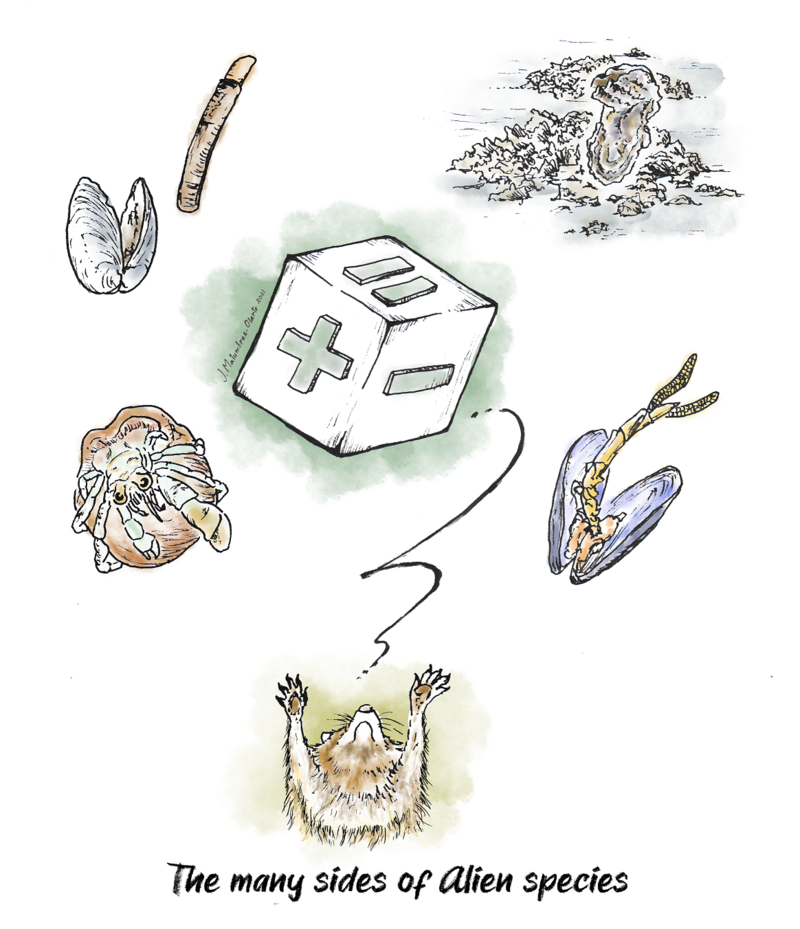 The image shown here symbolises the current debate about alien (exotic, non-native) species in the Wadden Sea: how alien species should be treated in the Wadden Sea. As discussed in the alien species session during the Symposium, these species may have positive, negative or no effects (shown on the different sides of the die) for local biodiversity and society: the saltwater clam Ruditapes phlippinarum and razor clam Ensis leei (top left); the habitat changing oyster Magallana gigas (top right); the intestinal copepod parasite of bivalves Mytilicola orientalis, (illustrated with a native blue mussel, bottom right); the hermit crab Diogenes pugilator (bottom left); and the racoon dog (bottom).
The image shown here symbolises the current debate about alien (exotic, non-native) species in the Wadden Sea: how alien species should be treated in the Wadden Sea. As discussed in the alien species session during the Symposium, these species may have positive, negative or no effects (shown on the different sides of the die) for local biodiversity and society: the saltwater clam Ruditapes phlippinarum and razor clam Ensis leei (top left); the habitat changing oyster Magallana gigas (top right); the intestinal copepod parasite of bivalves Mytilicola orientalis, (illustrated with a native blue mussel, bottom right); the hermit crab Diogenes pugilator (bottom left); and the racoon dog (bottom).
Marine Mammals
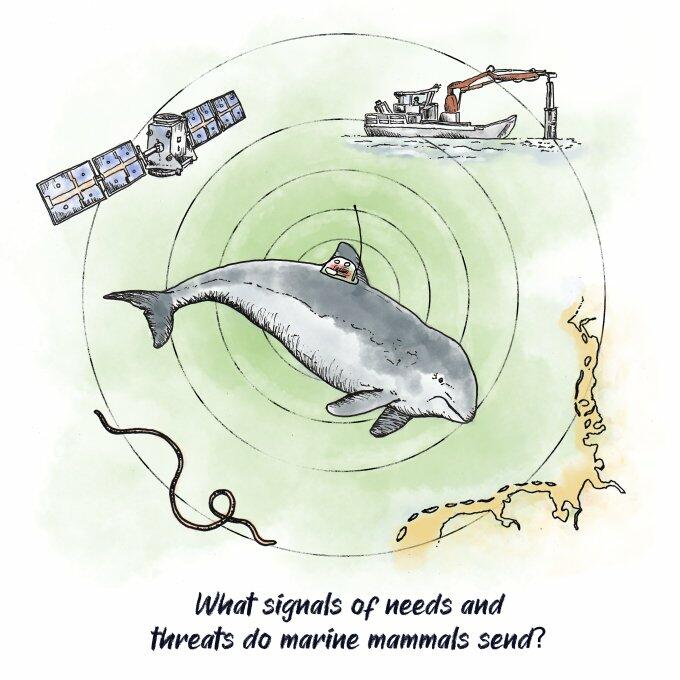 This image resumes the research subjects of the seminars presented in the marine mammal session of the Symposium: the species monitoring using telemetry; the (intertidal) habitats used and needed by the different species; the effects of anthropogenic activities (e.g. through noise); and the impact of diseases on the reproduction and population demographics. All these factors must be considered for the management of marine mammals in the Wadden Sea.
This image resumes the research subjects of the seminars presented in the marine mammal session of the Symposium: the species monitoring using telemetry; the (intertidal) habitats used and needed by the different species; the effects of anthropogenic activities (e.g. through noise); and the impact of diseases on the reproduction and population demographics. All these factors must be considered for the management of marine mammals in the Wadden Sea.
Birds
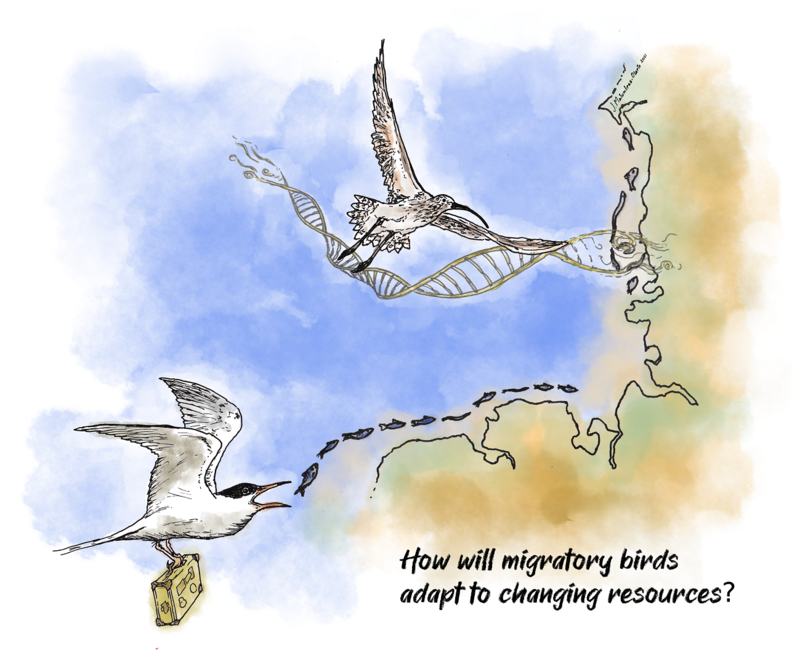 The birds in this image represent the migration through he Wadden Sea that may be determined by the resources available in the area (the tern with the suitcase and the fish-looking islands) and the genetic trigger in each species (Numenius arquata and the DNA helix).
The birds in this image represent the migration through he Wadden Sea that may be determined by the resources available in the area (the tern with the suitcase and the fish-looking islands) and the genetic trigger in each species (Numenius arquata and the DNA helix).
Sublittoral Habitats
 This image shows the mapping of sublittoral habitats by a research vessel using scan sonars and the four current features of/initiatives in these habitats in the Wadden Sea: the invasion of Ensis leei and Magallana gigas (bottom); the evaluation surveys on native Mytilus edulis musselbeds (second from the bottom); the restoration of Zostera seagrass (third from the bottom); and the decline of reef-forming Sabellaria spinulosa worms. The upwards direction of the sea represents the rise in the sea level.
This image shows the mapping of sublittoral habitats by a research vessel using scan sonars and the four current features of/initiatives in these habitats in the Wadden Sea: the invasion of Ensis leei and Magallana gigas (bottom); the evaluation surveys on native Mytilus edulis musselbeds (second from the bottom); the restoration of Zostera seagrass (third from the bottom); and the decline of reef-forming Sabellaria spinulosa worms. The upwards direction of the sea represents the rise in the sea level.
Sustainable Development - Ecology
 The image shows the “Pandora’s Box” of the measurement of biodiversity change (in multiple dimensions), which could assist us understand the drivers behind it, necessary for ecosystem status assessments in the face of climate change. These measurements and assessments may show how the recovery of seegrass habitats may be achieved and what effects climate change may have on the carbon sequestrated in salt marshes. The worms represent the effects of bioturbation on sediments (not fully understand) and the map of the Wadden Sea on the side of the box is a hint on the effects of climate change on the phenology (migration patterns) of certain species like the plaice.
The image shows the “Pandora’s Box” of the measurement of biodiversity change (in multiple dimensions), which could assist us understand the drivers behind it, necessary for ecosystem status assessments in the face of climate change. These measurements and assessments may show how the recovery of seegrass habitats may be achieved and what effects climate change may have on the carbon sequestrated in salt marshes. The worms represent the effects of bioturbation on sediments (not fully understand) and the map of the Wadden Sea on the side of the box is a hint on the effects of climate change on the phenology (migration patterns) of certain species like the plaice.
Sustainable Development - Social-Cultural
 The sphere in this image is based on the classic ying-yang symbol and represents the dichotomy between nature (left) and culture-society (right). This separation is not often (and should not be) clear, like in the case of the tourists that enjoy nature (bottom left). Also, the locals (top right) usually develop a mixture motion of both (by seeing them as part of the same landscape) and a sense of stewardship (hence her/his holding the tree). The book and the flying pages represent the role of literature in understanding and achieving sustainable development. The sunken church tower represents the flooded towns in Frisian marshands and the interactions between nature and human landscapes.
The sphere in this image is based on the classic ying-yang symbol and represents the dichotomy between nature (left) and culture-society (right). This separation is not often (and should not be) clear, like in the case of the tourists that enjoy nature (bottom left). Also, the locals (top right) usually develop a mixture motion of both (by seeing them as part of the same landscape) and a sense of stewardship (hence her/his holding the tree). The book and the flying pages represent the role of literature in understanding and achieving sustainable development. The sunken church tower represents the flooded towns in Frisian marshands and the interactions between nature and human landscapes.
International Perspectives
 The two birds (Calidris canutus and Mergus squamatus) represent, at the same time, two migratory flyways (East Atlantic and Australasian, respectively) and the research and management groups that work in different parts of the world. These groups (the birds) may collaborate with each other (sharing knowledge, experience, assessment tools and actions) to develop better sustainable development strategies, and to better protect and manage coastal habitats and the related heritage. These actions may include the restoration of coastal habitats (represented in the illustration by reefs formed by Sabellaria spinulosa worms), as a strategy to adapt to climate change (represented by the orange dawn) and the rise of the sea level (represented by the rising hand).
The two birds (Calidris canutus and Mergus squamatus) represent, at the same time, two migratory flyways (East Atlantic and Australasian, respectively) and the research and management groups that work in different parts of the world. These groups (the birds) may collaborate with each other (sharing knowledge, experience, assessment tools and actions) to develop better sustainable development strategies, and to better protect and manage coastal habitats and the related heritage. These actions may include the restoration of coastal habitats (represented in the illustration by reefs formed by Sabellaria spinulosa worms), as a strategy to adapt to climate change (represented by the orange dawn) and the rise of the sea level (represented by the rising hand).
